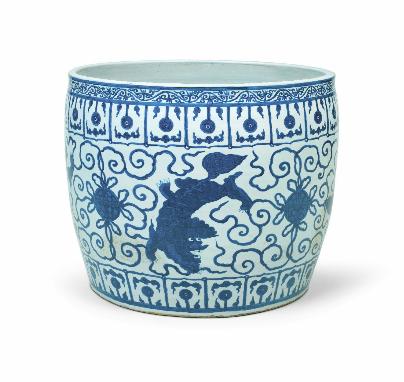

33.
FISH BOWL
WHITE PORCELAIN DECORATED IN UNDERGLAZE BLUE
JINGDEZHEN KILNS, JIANGXI PROVINCE
MING DYNASTY, JIAJING MARK AND PERIOD (1522–1566)
HEIGHT 61 CM; RIM DIAMETER 73.5 CM;
BASE DIAMETER 61.5 CM
INV. NO. 630
Fish bowl with gradually widening walls that
curve slightly inwards just below the rim,
made on a wheel in three parts from thick,
heavy porcelain, covered with blue-tinged
glaze except on the slightly recessed base,
which turned orange during firing.
The decoration is painted in deep, bright
underglaze blue and comprises four Buddhist
lions, each separated by a brocade ball
wrapped in long, elaborately interwoven
ribbons. The lions are vigorously and
vivaciously represented in different
positions, with round eyes, very curly manes,
long hair on the body and legs, with
four-clawed paws and bushy tails, their open
mouths revealing teeth and protruding
tongues. The lions are placed between two
lotus panel borders with clouds and
bi
discs,
the upper panel inverted. Around the rim a
classic scroll. Below a lotus panel beside
the head of one of the lions a horizontal
six-character mark of the Emperor Jiajing:
da Ming Jiajing nian zhi
(made in the Jiajing
period of the great Ming dynasty) in a
cartouche.
The lion is not native to China and was
introduced during the Eastern Zhou period
(770-256 BC). When present in Buddhist
sculptures, the animal traditionally appears
guarding Buddha and in that context is
generally associated with protection and the
law.
The lion first appeared as a decorative motif
during the Tang dynasty (618-907). A lion
playing with a brocade ball first appeared on
Chinese ceramics during the Song dynasty
(960-1279), and was probably inspired by
the silks of the Northern Song period
(960-1127). 1
This fish bowl was made and probably
painted by the same potter who decorated
the preceding example (cat. 32), which
certainly came from the same workshop
and perhaps even from the same batch.
Fish bowls decorated with dragons are more
numerous than those with lions.
1 Pierson, 2001, p. 86, nos. 85 and 86.
84 .
PORCELAIN OF THE YUAN (1279–1368) AND MING (1368–1644) DYNASTIES